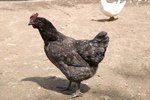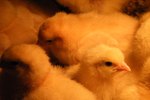Things You'll Need
Starter/grower feed
Poultry water fount
Egg carton or poultry feeder
Large plastic storage bin
Straw or shredded paper
Heat lamp
100 watt or greater bulb
Layer feed
Chicken house
Bantams are a special variety of chicken that is roughly one-half to three-fourths the size of a regular chicken. They come in many different breeds and colors, some clean legged, some feather footed. Bantams are a real crowd-pleaser because of their small stature. While bantams or bantees are similar to chickens in their care and life cycle, they do require certain special considerations in their modicum of care.
Caring for Bantam Chicks
Fill the bottom of your plastic tub with one inch of shredded paper or straw if beginning with chicks. Be sure the bottom of your box is not slick, as bantams are prone to "spraddle legs" or displaced hips when on slick surfaces.
Fill your water fount with clean water daily. If any slime or buildup occurs, scrub the plastic and rinse with hot water and dish soap. Do not use bleach on plastic founts as it will degrade the plastic rapidly.
Fill your egg carton cups or feeder with starter feed from your local feed store. Protein content should be 18 to 22 percent. Feed medicated with sulfa drug is optional and should prevent coccidiosis, but may make them more susceptible to other illnesses and infections later on. Bantams may benefit from a high-protein feed such as game bird starter if it is available.
Hang a heat lamp on one side of your pen. The temperature level at the floor of the box should be 95 degrees F. Raise or lower your light to adjust the temperature. Bantams cannot withstand rapid temperature changes. Be sure the room your box is in does not have a heat or air vent blowing directly on the box.
Place feed and water containers on one side of the bin and the heat lamp on the other. Chicks should be able to move easily from one place to another without being too crowded. Chicks should also be able to get under the light or away from it to regulate their body temperatures.
Watch the chicks carefully. If they are huddled under the light, they are too cold. If they are spread out with their wings hanging and are panting through their mouths, they are too hot. Each week of life, chicks can withstand a five degree temperature decrease (that is, one-week old birds, 90 degrees; two-week old birds, 85 degrees). Chicks should remain indoors for at least the first four weeks.
Make food and water available all day and night. Keep the light on all day and night as well. Clean the litter at least once a day to ensure the health of the chicks. Should you ever see blood in their droppings, they need to be treated with coccidiosis with a soluble sulfa drug from your local feed store.
Caring for Adult Bantams
Move adult or adolescent bantams to a pen when they are fully feathered and large enough that they will not be able to squeeze through the wiring on their pen or house. Chicken houses should have at least two square feet of space for each bantam, preferably more. Each house should have nesting boxes and a roost for birds to get off of the ground.
Place two to three inches of straw on the floor of your chicken house. Fill a feeder with layer feed (16 to 18 percent protein). Fill your poultry fount with water. Each should be located where birds can easily access them.
Check the birds each day for illness. Give them fresh food and water each day and collect their eggs. Change litter as needed, but at least once every four weeks.
Install a fan to circulate air during hot summers, if the temperature is too hot for the birds to remain in the house. During the winter, use heavy plastic to cover open areas of wire on the house to ensure that the chickens do not get too cold. Bantams are more susceptible to illness and death related to weather change than standard-sized chickens.
Check your birds for mucous in their eyes, nostrils or mouth which are symptoms of a respiratory infection. Birds with respiratory infection need to be treated with an antibiotic for a week. If birds look to have neurological impairment and unusually runny feces, they need to be treated for a bacterial infection with a soluble medication. If birds have bloody places and have been picking or fighting, a no-pick solution or petroleum jelly mixed with pepper applied topically will prevent picking.
Tips
If a material is unavailable, improvise. If starter/grower combination feed is unavailable, you can use starter for the first few weeks and switch to a grower after that. Learn about the special considerations related to different varieties of bantams. For example, the Silkie varieties do not have conventional feathers, making it more difficult for them to gain lift to reach higher roosts.
Warnings
Be careful about using wood chips or shavings for litter as they can harbor mold spores and cause respiratory infections. Never use sawdust as bedding as it is easily inhaled into a chicken's respiratory system.
Always wash your hands thoroughly after handling chicks and adult birds to prevent salmonella and other disease transmission.





